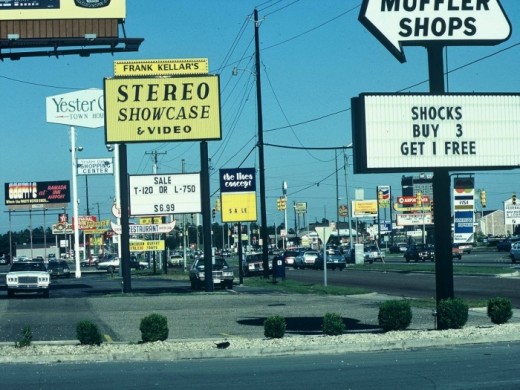During the development boom of the 1980’s, Time Magazine had a cover story article about what they called “America’s growing slow-growth movement.” The article began with a quote from a civic activist in Southern California, who said “we were in favor of progress, until we saw what it looked like.” Looks count! Aesethics matter!
Mark Twain put it this way, “We take stock of a city like we take stock of a man. The clothes or appearance are the externals by which we judge.”
Over 80 percent of everything ever built in America has been built since about 1950 and a lot of what we have built is just plain ugly. There are still many beautiful places in America, but to get to these places we must often drive through mile after mile of billboards, strip malls, junk yards, used car lots, fry pits, and endless clutter that has been termed “the geography of nowhere.”
The problem is not development, per se; rather the problem is the patterns of development. Successful communities pay attention to where they put development, how it is arranged, and what it looks like.
The image of a community is fundamentally important to its economic well-being. Every single day in America people make decisions about where to live, where to invest, where to vacation and where to retire based on what communities look like. Consider tourism, for example. The more any community in America comes to look just like every other community the less reason there is to visit. On the other hand, the more a community does to protect and enhance its uniqueness whether natural or architectural, the more people will want to visit. Tourism is about visiting places that are different, unusual, and unique. If everyplace was just like everyplace else, there would be no reason to go anyplace.
Successful communities pay attention to aesthetics. Typically they control signs, they plant street trees, they protect scenic views and historic buildings, and they encourage new construction that fits in with the existing community.
Editor’s note: Whether you’re in a big city or small town, dignified, well-designed public buildings can also make a huge difference. They also set an example for developers showing that the community truly believes in a high quality built environment.
Two public buildings in the small city of Port Royal, South Carolina (population, 11,000) set the standard. Port Royal’s city hall is above left; the fire station is above right (and, yes, even buildings like fire and police stations can and should be well-designed).
Take a look at Ed McMahon’s earlier article, Public Buildings Should Set the Standard, for more on the key role public buildings play.
Download all seven parts of The Secrets of Successful Communities in a single pdf file (note: the pdf does not include the several embedded videos)
Editor’s Note: Ed McMahon is one of the country’s most incisive analysts of planning and land use issues and trends. He holds the Charles Fraser Chair on Sustainable Development and is a Senior Resident Fellow at the Urban Land Institute in Washington, DC. McMahon is a frequent speaker at conferences on planning and land development. Over the past 21 years, we’ve been pleased to have published more than two dozen articles by McMahon in the Planning Commissioners Journal, and now on PlannersWeb.com.

